[Text Mining]Word embeddings
This post is based on the 732A92 Texting Mining course, given by Marco Kuhlmann at LiU in 2019.
Word embeddings
對於人來說,要理解文字並不是件困難的事,但對電腦來說,每個字不過是一串 string,所以當我們要做 text mining 時就必須要將這些 string 轉化成電腦可以理解的方式。 而 word embedding(word vector or word representation) 的概念就是將文字轉換成 vector ,好讓電腦可以讀懂文字間的關係。
譬如說,人類可以理解 pretty 和 beautiful 是相近詞,但如果只是給電腦這兩個單字,對於電腦來說,這只是兩個不同長度的 string 罷了。word embedding 會將這兩個字轉換成不同的 vector 映射到一個高維空間,當這兩個 vector 越接近(可以使用 consine similarity)就表示這兩個詞越相近。這就是 word embedding 主要的概念。
- A word embedding is a mapping of words to points in a vector space such that nearby words (points) are similar in terms of their distributional properties.
The distributional principle
word embedding 方法可以使用最重要的就是因為有 distributional hypothesis 這個假設。
- The distributional principle states that words that occur in similar contexts tend to have similar meanings.
這裡的概念是說,詞(target words)出現在類似的上下文中(context words),則它們很有可能有相似的意思。
譬如說,
-「那隻『貓』好可愛」
-「那隻『狗』好可愛」
這時候除了『貓』和『狗』外,這兩句話的上下文是一樣的,根據 distributional principle,這兩個詞應該是相似的。
Co-occurrence matrix
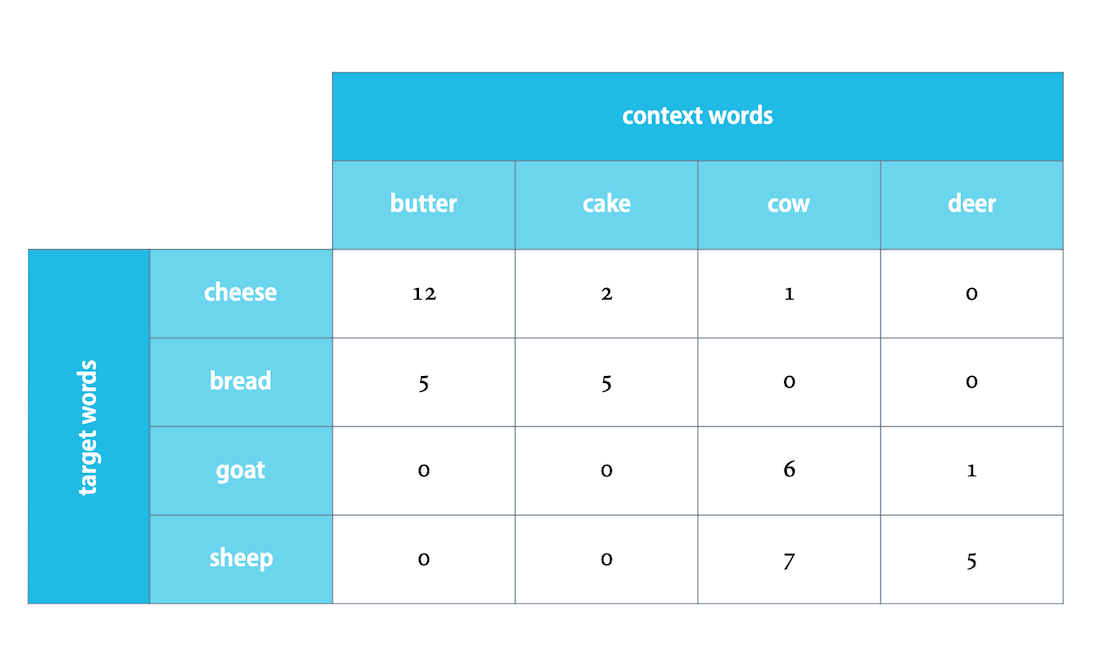
上圖中,context words 就是上下文,而 target words 就是我們想要分析的字詞。
現在來看 cheese 這個字,可以看到和 butter, cake, cow, deer 這幾個字一起出現的次數分別是,12, 2, 1和0次。看起來和 butter 還有 cake 連結性比較強。
再來看 bread 這個字,同樣的在 butter 和 cake 上的連結也比較強。如果我們把這兩個單字用向量表示就會是,(12, 2, 1, 0) 和 (5, 5, 0, 0),可以去比較和其他兩個單字的 cosine similarity,這兩個的關係是比較強的。
現在我們把它們畫出來(因為它們被映射到的是四維空間,所以老師的 slide 只看 cow 和 cake 這兩個 context words)
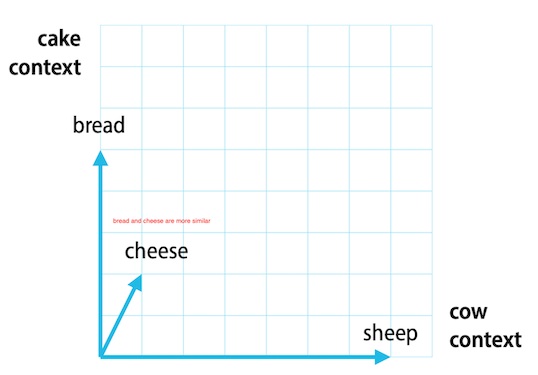
如果還是不太明白,這篇部落格應該可以看懂。
補充: 從上面的 matrix 可能會想到一件事,context words 等於是決定了 target words 的向量啊! 換句話說,當我們分析不同的文本的時候,會需要不同的 context words來算出 word embeddings。想像,如果今天要分析新聞報導和 ptt 內容,不太可能使用一樣的 context words,畢竟ptt用語和新聞用語會有很大的不同。(蛤?你說記者都抄 ptt 內容嗎?XDDD)
Simple applications of word embeddings
word embeddings 的應用
- finding similar words. 找到相似的字,像是上面的例子,找出哪一個字和 cheese 比較相似。
- answering ‘odd one out’ questions. 找出不一樣的詞,譬如說 lunch, breakfast, dinner, car 哪一個詞屬於不同類? (根據上面提到的概念,lunch, breakfast, dinner 這三個的 vector 應該會比較接近,會在比較接近的上下文中出現)
Limitations of word embeddings
-
There are many different facets of ‘similarity’. Ex. Is a cat more similar to a dog or to a tiger? (在不同情境下,cat 和 dog 可能比較相似。譬如說,貓和狗都是寵物,但如果以生物的角度來看,cat 和 tiger 都屬於貓科動物,這時候 cat 和 tiger 會比較相似)
-
Text data does not reflect many ‘trivial’ properties of words. Ex. more ‘black sheep’ than ‘white sheep’ (如果只分析文本,因為大部分的羊都是白色的,所以在提到羊的時候並不會特別提到顏色,但當提到比較稀少的黑羊時,反而會特別說到 black,這會導致在分析時好像黑羊出現的頻率比白羊出現的頻率高)
-
Word vectors reflect social biases in the data used to train them. Ex. including gender and ethnic stereotypes (論文參考) 很多詞語上的用法其實帶有非常多的社會偏見和刻板印象,而這也會導致分析出的結果有所偏差。
還有什麼問題?
到目前為止,看起來都非常合理,那還會有什麼問題呢?
這裡會碰到和之前提到過的,矩陣稀疏性的問題。如果今天 context words 有十萬個字,那麼 target words 就會是在十萬維度的空間的 vectors,而且可能會有很多的值都是 0 的狀況發生。那這樣要用什麼方法解決矩陣的稀疏性並產生 word embeddings(也就是每個詞的向量) 呢?
從不同的面向來看幾個常見的 word embedding 方法,
- Learning word embeddings via matrix factorization
- Singular Value Decomposition(SVD)
- Positive Pointwise mutual information(PPMI)
- Learning word embeddings via language models
- N-gram
- Neural language models(Ex. word2vec)
以下就要來介紹這幾種方法。
Matrix factorization - Singular Value Decomposition(SVD)
- The rows of co-occurrence matrices are long and sparse. Instead, we would like to have word vectors that are short and dense. 簡單來說,co-occurrence matrices 會有稀疏性的問題。
- One idea is to approximate the co-occurrence matrix by another matrix with fewer columns. Singular Value Decomposition 的想法是,將這個又長又臭的 co-occurrence matrix 用另比較少 columns 的 matrix 取代。
什麼是 Singular value decomposition(奇異值分解)?
- Singular value decomposition(SVD) can be applied on any matrix. (不需要是方陣。比較:PCA(特徵值分解) 也是一個降維的方法,但它的矩陣就必須要是方陣。)
SVD 的概念就是,任一一個矩陣 \(A_{m \times n}\),它都可以拆解成三個矩陣(\(U_{m \times n}, \Sigma_{m \times n}, V^T_{n \times n}\))的相乘。
其中,\(U_{m \times n}\) 的 columns 是 Orthonormal,而 \(V^T_{n \times n}\) 的 rows 是 Orthonormal,\(\Sigma_{m \times n}\) 是 Diagonal(只有對角線有非負的值,且由大到小)。
(在線性代數中,一個內積空間的正交基(orthogonal basis)是元素兩兩正交的基。稱基中的元素為基向量。 假若,一個正交基的基向量的模長都是單位長度1,則稱這正交基為標準正交基或”規範正交基”(Orthonormal basis)。)
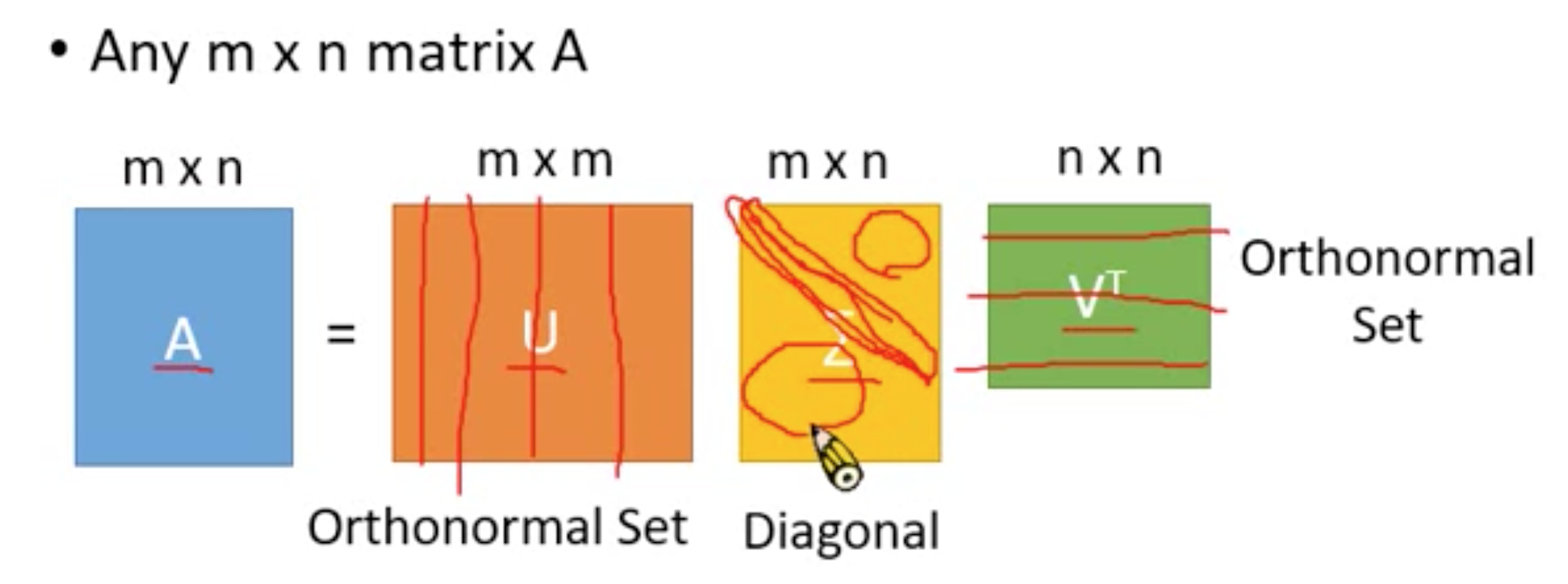
- \(\Sigma_{m \times n}\) 會是一個長得像這樣的矩陣,且 \(\sigma_1 \ge \sigma_1 \ge \ldots \ge \sigma_k\)
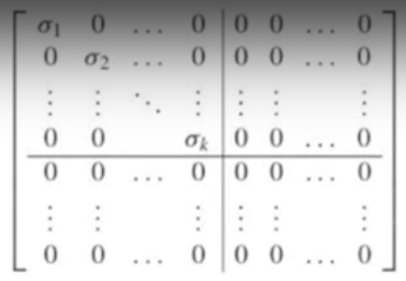
而 \(\sigma_r, ~~where~~1 \le r \le k\) 是奇異值(singular value),而 r 越小也代表了該值越重要,換句話說,含有越多訊息,因此我們可以只保留 \(\Sigma\) 較重要的前面幾行得到一個相似的矩陣 \(A\)。用較小的儲存空間就可以得到接近原始的矩陣 \(A\)。
\[A_{m \times n} \approx U_{m \times r} \times \Sigma_{r \times r} \times V^T_{r \times n}\]參考線代啟示錄-奇異值分解 (SVD)的圖,
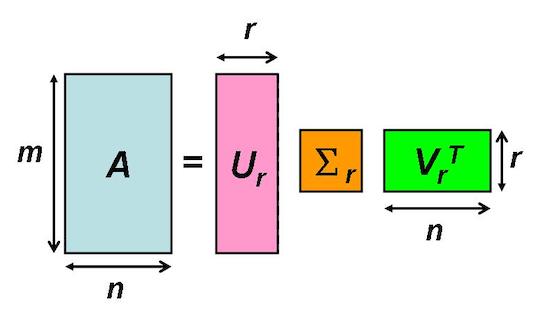
回到我們的 word-embedding。我們可以利用 SVD 進行去噪及降維,刪除一些不那麼重要的訊息,用來解決 Co-occurrence matrix 稀疏性的問題。
我們也不需要再將相乘矩陣,直接使用 𝑼 就好,每一列就代表一個 target word。
- Each row of the (truncated) matrix 𝑼 is a k-dimensional vector that represents the ‘most important’ information about a word.
- A practical problem is that computing the singular value decomposition for large matrices is expensive.
這邊看一個例子,
下圖是一個 Co-occurrence matrix \(~A_{m \times n}\)
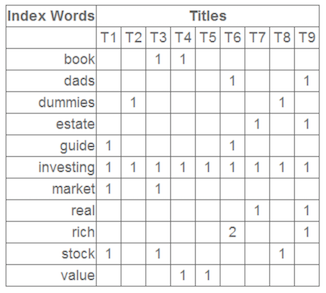
將上面的矩陣 \(A\) 使用 SVD 分解、降維,只留下前三個特徵值。每個特徵值的大小表示對應位置的屬性值的重要性大小,左奇異矩陣的每一列即代表每個詞的特徵向量,右奇異矩陣的每一行表示每個文件的特徵向量。
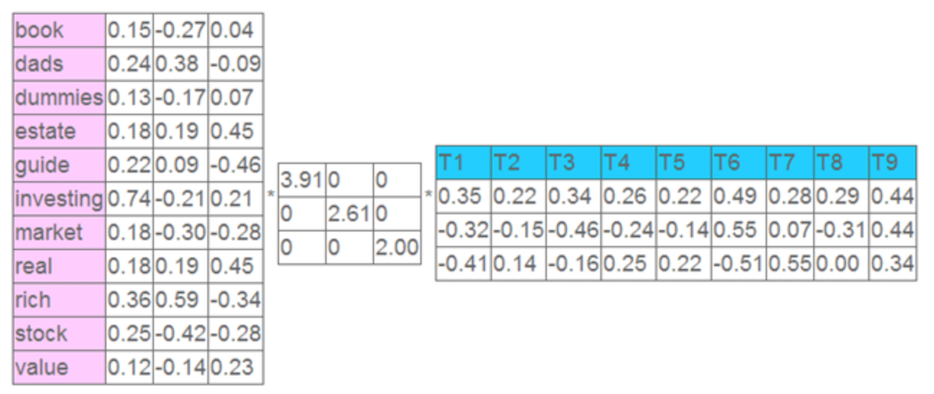
取每個向量後兩維的對應值投影到一個二維空間,如下所示
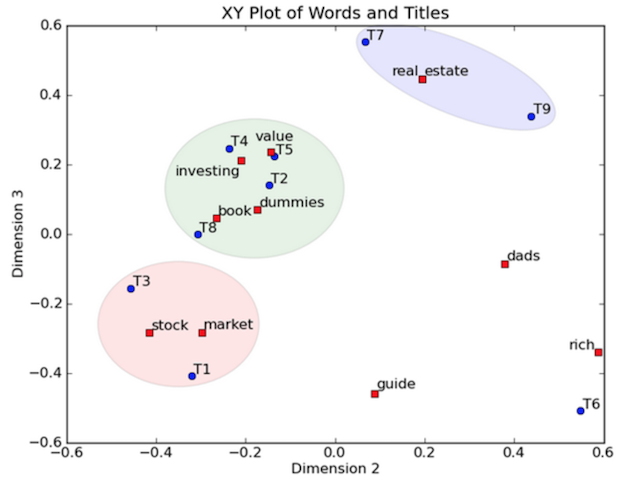
上圖中,一個紅色的點對應一個詞,一個藍色的點對應一個文件。當這些點被投影到空間中,我們可以對這些詞和文件進行分類,比如說stock和market可以放在一類,real和estate可以放在一類,按這樣的分類結果,我們就可以知道文件中哪些事相近的詞,所以當使用者利用詞搜尋文件的時候,我們就可以利用相近的詞(在向量空間中相近的詞、被歸為同一類的詞)進行檢索,而不是只是使用完全相同的詞搜尋。
Matrix factorization - Positive Pointwise mutual information(PPMI)
Pointwise mutual information(PMI)
-
Raw counts favour pairs that involve very common contexts.
E.g. the cat, a cat will receive higher weight than cute cat, small cat. -
We want a measure that favours contexts in which the target word occurs more often than other words.
-
A suitable measure is pointwise mutual information (PMI):
簡單來說,我們可以用 PMI 公式來看兩個字之間的關係。
現在我們把 \(x\) 看成我們的 target word,\(y\) 看成我們的 context word,
- We want to use PMI to measure the associative strength between a word \(w\) and a context \(c\) in a data set \(D\):
但根據上面的公式,會發現一個問題,PMI is infinitely small for unseen word–context pairs, and undefined for unseen target words. (如果 \(w\) 和 \(c\) 並沒有共同出現過,再取 log,整個值會變成 -Inf)
所以這時候就有了 Positive Pointwise mutual information(PPMI)。
- In positive pointwise mutual information (PPMI), all negative and undefined values are replaced by zero:
- PPMI assigns high values to rare events, it is advisable to apply a count threshold or smooth the probabilities.
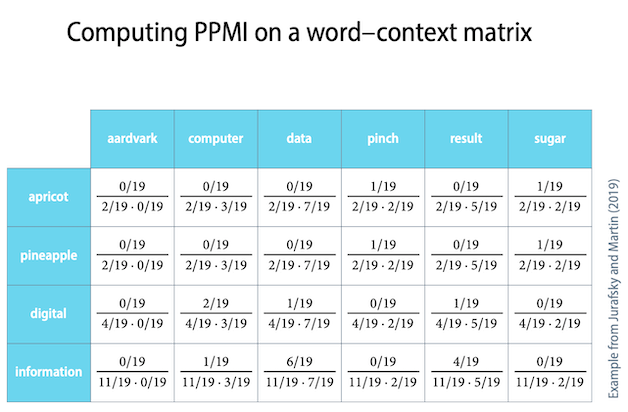
看一個例子,
下圖是一個 Co-occurrence matrix,列是 target words,行是 context words

假設這篇文章總共只有 19 個字,這裡我們計算 x = information,y = data 的 PMI 值,
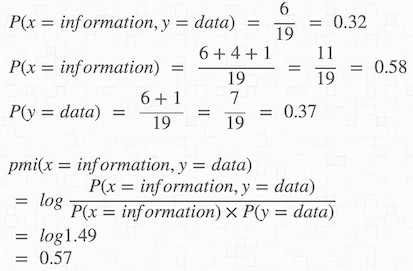
根據同樣的方式可以求出所有 target words 對應的 context words 的 PMI 值。
Language models
- A probabilistic language model is a probability distribution over sequences of words in some language.
- Recent years have seen the rise of neural language models, which are based on distributed representations of words.
- By the chain rule, the probability of a sequence of 𝑁 words can be computed using conditional probabilities as
- To make probability estimates more robust, we can approximate the full history \(w_1 \ldots w_N\) by the last few words (馬可夫鍊):
Language models - N-gram models
-
An n-gram is a contiguous sequence of n words or characters.
E.g. unigram (Text), bigram (Text Mining), trigram (Text Mining course) -
An n-gram model is a language model defined on n-grams – a probability distribution over sequences of n words.
-
n-gram 是一種語言機率模型。一句話出現的機率是一個聯合模型。如果一個詞的出現只考慮前面一個字,那就是 bi-gram;如果一個詞的出現考慮前面兩個字,那就是 tri-gram。
Formal definition of an n-gram model
- \(n\): the model’s order (1 = unigram, 2 = bigram, …)
- \(V\): a set of possible words (character); the vocabulary
- \(P(w\mid u)\): a probability that specifies how likely it is to observe the word \(w\) after the context
(n − 1)-gram \(u\)
Unigram model
n = 1 不考慮前面出現的字。
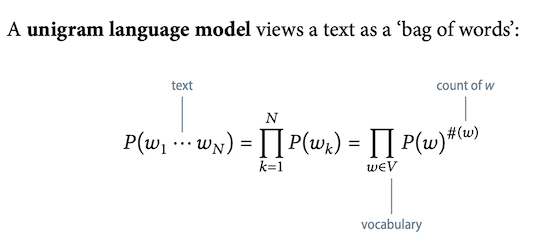
Thus contexts are empty.
MLE of unigram probabilities
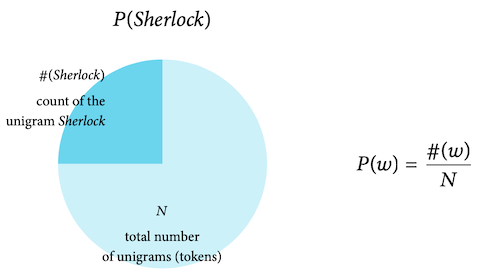
Bigram models
n = 2 考慮前面出現的一個字。
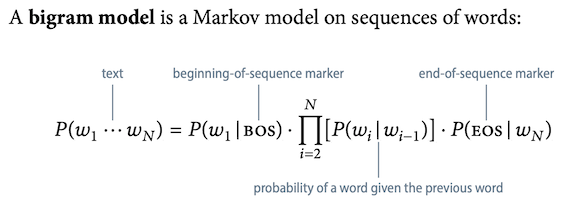
Thus contexts are unigrams.
Estimating bigram probabilities
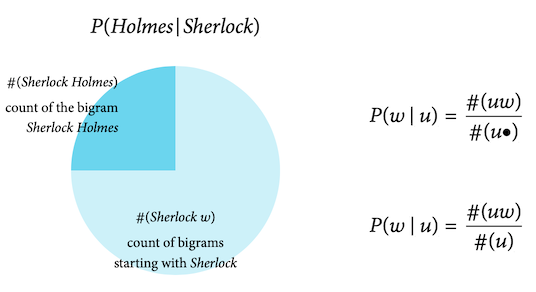
Example
(source)
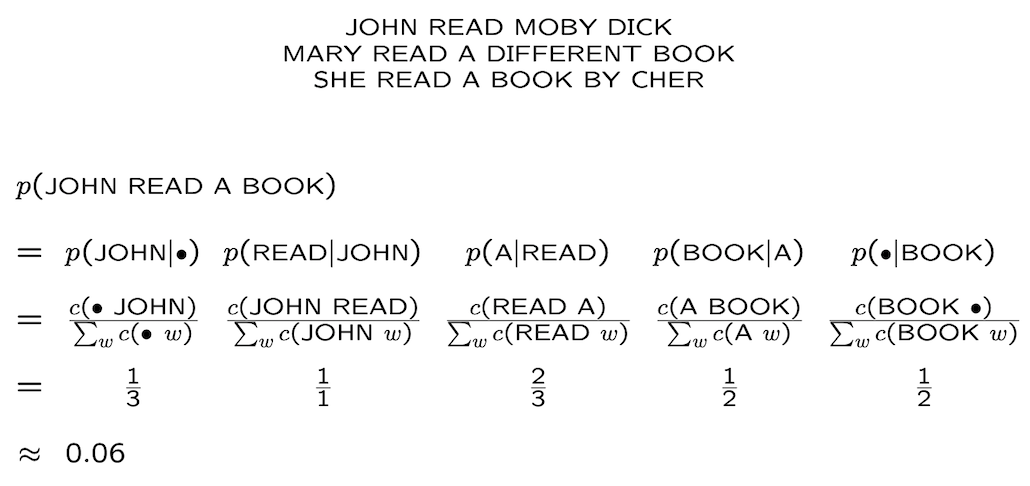
Smoothing
當在計算 bigram 時可能會碰到兩個字完全沒有相鄰的狀況,這會導致算出來的機率等於 0。(如下圖)
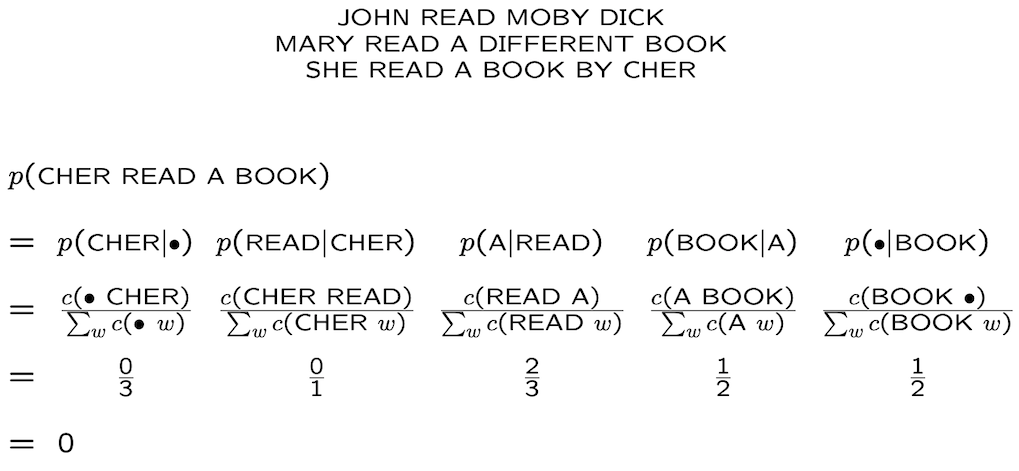
這種時候就需要用到,smoothing。
Smoothing methods
- Additive smoothing
- Good-Turing estimate
- Jelinek-Mercer smoothing (interpolation)
- Katz smoothing (backoff)
- Witten-Bell smoothing
- Absolute discounting
- Kneser-Ney smoothing
上面的狀況碰到的是,”CHER” 後面沒有出現 “READ” 的狀況,而導致機率等於0,但如果現在是 “CHER” 這個字從未出現在資料集中呢?這種狀況時,smoothing 便派不上用場了。
- In addition to unseen words, a new text may even contain unknown words. For these, smoothing will not help.
Unknown words
建立一個 token
- A simple way to deal with this is to introduce a special word type UNK, and to smooth it like any other word type in the vocabulary.
- When we compute the probability of a document, then we first replace every unknown word with UNK.
Language models - Neural networks as language models
Advantages of neural language models
- Neural models can achieve better perplexity than probabilistic models, and scale to much larger values of n.
- Words in different positions share parameters, making them share statistical strength. (Everything must pass through the hidden layer.)
- The network can learn that in some contexts, only parts of the n-gram are informative. (implicit smoothing, helps with unknown words)
word2vec
- word2vec 是 word embedding 的一種
-
word2Vec 主要有 CBOW (continuous bag-of-words) 和 skip-gram 兩種模型
- CBOW 是給定上下文,來預測輸入的字詞;Skip-gram 則是給定輸入字詞後,來預測上下文
Reference:
732A92 Texting Mining
詞向量介紹
自然語言處理 – Vector Space of Semantics
[NLP] 秒懂词向量Word2vec的本质
李宏毅老師的線性代數 - SVD
NLP 笔记 - 再谈词向量
機器學習筆記之二十二——PCA與SVD
線代啟示錄-奇異值分解 (SVD)
自然語言處理 – Pointwise Mutual Information
NLP Lunch Tutorial: Smoothing
機器學習五分鐘:自然語言處理(NLP)的N-gram模型是什麼?
詞向量(one-hot/SVD/NNLM/Word2Vec/GloVe)
